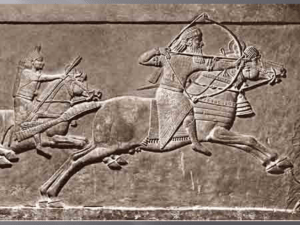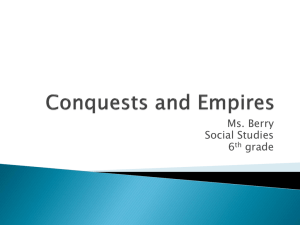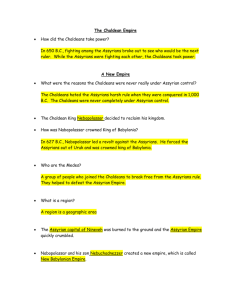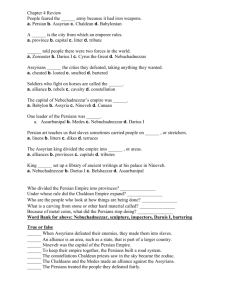Assyrian Empire
advertisement
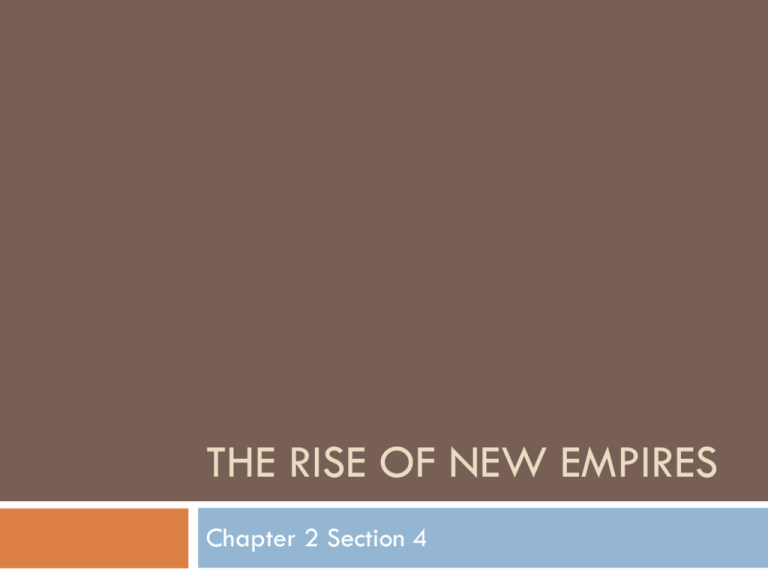
THE RISE OF NEW EMPIRES Chapter 2 Section 4 The Assyrian Empire The Assyrians came from the northern part of Mesopotamia. The Assyrian Empire would eventually include Iran, sections of Asia Minor, Syria, Israel and Egypt. The Assyrian Empire The Assyrian Empire Because of the size of the empire, it was divided into provinces that were headed by a governor. A network of roads protected by soldiers was built to improve communication and trade throughout the empire. This network allowed for a governor from anywhere in the empire to send a question to the king and receive an answer within a week. The Assyrian Empire The Assyrian army was large, well organized and disciplined. The army was organized into infantry, cavalry, and horse drawn chariots. The army could use different military tactics such as guerilla warfare, battles on open plains, and lay siege to cities. The Assyrian Empire The Assyrians treated their conquered people cruelly by burning their cities, torturing and killing prisoners, and deporting entire populations from their homelands. They would force the people under their control to pay heavy taxes to pay for improvements in Nineveh, the Assyrian capital. The Assyrian Empire The attack on Nineveh by the Medes and the Chaldeans ended the Assyrian Empire. The Assyrians faced continual revolt from the people under their rule as a result of their cruel treatment. Eventually around 612 B.C. two groups, the Chaldeans and the Medes allied and defeated the Assyrians. The Assyrians: Masters of War The Chaldeans The Chaldeans or the “NeoBabylonians”, were descendants of Hammurabi’s Babylonian Empire in the 1700’s B.C. After the fall of the Assyrian Empire the Chaldeans would rise to prominence in Mesopotamia. They would reach the apex, or height of their power under the rule of Nebuchadnezzar, who ruled from 605 B.C. to 562 B.C. The Chaldeans Nebuchadnezzar would extend the boundaries of the Chaldean Empire as far west as Syria and Canaan, forcing the people of Judah into exile in Babylon. The Chaldeans would gain great wealth from their conquests and rebuild Babylon as on the largest, most beautiful cities of the ancient world. The Chaldeans The Chaldeans Two of the things that made Babylon so beautiful were the Hanging Gardens and the Wall of Babylon. Both are considered to be among the Seven Wonders of the Ancient World. Artist’s rendition of the Hanging Gardens The Ishtar Gate one of eight city gates in Babylon. The Persians The Chaldeans would weaken after the death of Nebuchadnezzar and would eventually be conquered by the Persians in 539 B.C. The Persians originated in central Asia and settled in Mesopotamia around 2000 B.C. in what is now Iran. The Persians Cyrus II developed a strong army and conquered the Medes , Northern Mesopotamia, Syria, Canaan, and the Phoenicians. In 525 B.C. Cyrus II’s son Cambyses conquered Egypt, bringing all of the Middle East under Persian control. The Persian Empire would stretch from the Nile River to the Indus River, a distance of 4,800 Kilometers and included 50 million people. The Persians The Persians Darius I who ruled from 522 to 486 B.C. organized the Empire into provinces and assigned provincial governors, or Satraps to rule. Military and tax officials were chosen by the king from the conquered people and assisted Satraps in implementing the Kings policies in the provinces. A uniform monetary system was introduced and he made Aramaic the official language of the Empire. Darius I also employed agents known as “Eyes and Ears of the King” to inspect the running of the provinces. Darius I organized the Persian Empire The Persians The Persians had learned lessons from the Assyrians on how not to treat conquered people. Lands and people that had been conquered by the Persians were allowed to keep local languages, traditions, religions, and some laws. This action by the Persians would earn them loyalty from the people they had conquered. The Persians Darius I brought artisans from many of his conquered lands to build his capital at Persepolis. Roads were built to encourage trade as well as ease the movement of troops. The Royal Road was the most important road built; it ran from Susa to Sardis. Spanning 1,400 Kilometers it had stations every 14 Kilometers to provide travelers with food and fresh horses. Royal Messengers could travel the road in seven days, a journey that had previously taken three months. The Royal Road ran from Susa to Sardis a distance of 1,400 Kilometers. The Royal Road & Trade Routes The Persians All of the rebellions during the reign of Darius I were quelled, including the Ionian rebellion of 499 B.C. in Asia Minor. In 499 B.C. the Ionian Greek CityStates revolted against Persia with the help of Athens and other mainland Greek city-states. Darius I would send 30,000 troops to punish Athens for its interference only to be defeated at Marathon in 490 B.C. The Greco-Persian Wars 500-479 B.C. The Persians Darius I would die in 486 B.C. while making preparations for another, larger invasion of Greece. His son Xerxes would succeed him as king and would lead a force to conquer Greece that would cripple the Persian Empire. “Xerxes at the Hellespont”, by Jean Adrien Guignet “Xerxes at the Hellespont”, by Jean Adrien Guignet Engineering an Empire: The Persians

